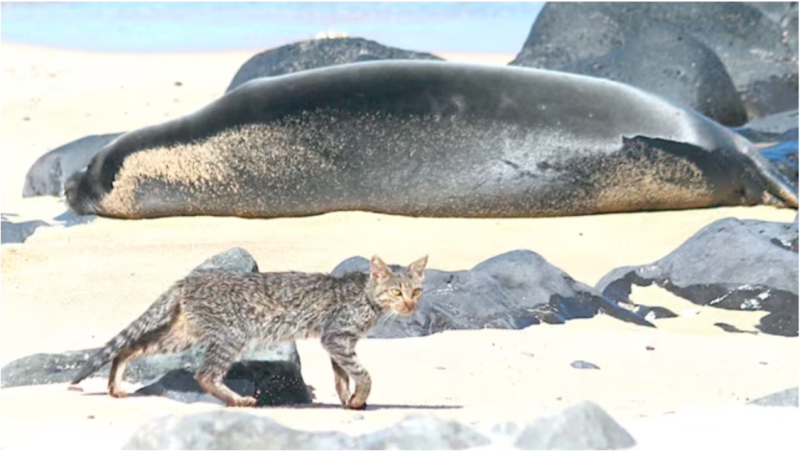Here in the Hawaiian Islands, it’s easy to see the interdependence between people and the natural environment and the interconnectedness of land and sea. The scientific concept of “One Health” highlights these connections, emphasizing the linkages among human, animal, and environmental health. Governor Green has proclaimed January to be Hawaiʻi One Health Month to support, strengthen, and expand One Health-related efforts and increase awareness of its principles to improve human health, animal health, environmental stewardship, and prospects for agriculture and fisheries.
The NOAA Hawaiian Monk Seal Research Program applies One Health concepts when we study Hawaiian monk seals’ health. Toxoplasmosis is the greatest disease threat to monk seals in the main Hawaiian Islands. It provides an example of a One Health system at the intersection of human-domestic-wild animal disease.
- Domestic animals (cats): The Toxoplasma organism can only sexually reproduce inside the gut of a cat, which makes cats the main distributor of the infectious material in the environment.
- Environment: Rainfall carries the parasite through the watershed, spreading from mauka to makai (mountains to sea).
- Humans: People can get toxoplasmosis by accidentally ingesting itin the environment (for example while gardening or tending cats) or from food (unwashed produce or undercooked meat). =Toxoplasmosis is a leading cause of death from foodborne illness in the United States.
- Wildlife (Hawaiian monk seals): Toxoplasmosis can infect all warm-blooded animals and has been deadly to some endangered birds in Hawaiʻi. It is especially deadly to Hawaiian monk seals, and is one of the top causes of their death in the main Hawaiian Islands. This disease hits adult females especially hard, because it can hurt the population’s potential for reproduction and recovery.
Such a complex problem requires complex solutions. That’s why NOAA Fisheries uses the One Health framework and works with experts in social science, veterinary medicine, biology, ecology, hydrology, and more. We play an active part in the Toxoplasmosis and At-large Cat Technical Working Group and have helped to establish the Pono Pet Parent Partnership. This partnership facilitates collaboration among animal care, conservation, and natural resource management organizations and/ agencies. It provides resources for anyone to contribute to a healthy system for humans, pets, and Hawaiian wildlife.
You can be part of the One Health action to fight toxoplasmosis too! Take the Pono Cat Parent Pledge and learn how to keep your pets and wildlife safe. And as part of One Health Month, share your adventures with your happy indoor cat with the tag #PonoCatParent.






